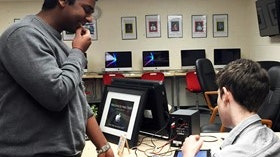Homepage
•
Learning Library
•
Blog
•
Student-run genius bar: The facilitator's guide
Expand breadcrumbs
Expand breadcrumbs
- Learning Library
- Blog
- Student-run genius bar: The facilitator's guide
- Homepage
- •
- Learning Library
- •
- Blog
- •
- Student-run genius bar: The facilitator's guide
Student-run genius bar: The facilitator's guide
By LeRoy Wong, Gati Aher, and Jennifer Scheffer
May 30, 2019








